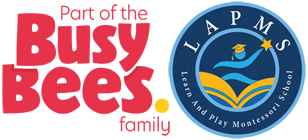Montessori is a comprehensive educational approach from birth to adulthood, based on the observation of children’s needs in a variety of cultures all around the world. Beginning her work almost a century ago, Dr. Maria Montessori developed this educational approach based on her understanding of children’s natural learning tendencies as they unfold in “prepared environments” for multi-age groups (0-3, 3-6, 6-9, 9-12, and 12-14).
The Montessori environment contains specially designed, manipulative “materials for development” that invite children to engage in learning activities of their own individual choice. Under the guidance of a trained teacher, children in a Montessori classroom learn by making discoveries with the materials, cultivating concentration, motivation, self-discipline, and a love of learning.
Dr. Maria Montessori believed that the most important years of a child’s education are not the years of high school and college, but the first six years of life. As a result, Montessori schools regard infant and early childhood education as the very foundation of everything that follows. A child’s mind is absorbent, and his curiosity is at a peak during these early years. When properly nourished and stimulated, the child’s mind forms patterns of learning which serve him throughout his life. A Montessori school provides one of the most effective environments in which to guide a child through these critical years.
For children under six years old, Montessori emphasizes learning through all five senses, not just through listening, watching, or reading. Children in Montessori classes learn at their own, individual pace and according to their own choice of activities from hundreds of possibilities. They are not required to sit and listen to a teacher talk to them as a group, but are engaged in individual or group activities of their own, with materials that have been introduced to them 1:1 by the teacher who knows what each child is ready to do. Children choose their work from among the self-correcting materials displayed on open shelves, and they work in specific work areas. The materials and exercises are designed to stimulate independent exploration. More experienced children share what they have learned while reinforcing their own learning. Because this peer group learning, there is often more conversation in the Montessori classroom than in conventional early education settings. Learning is an exciting process of discovery, leading to concentration, motivation, self-discipline, and a love of learning.
American Montessori Society (AMS). The American Montessori Society is the foremost advocate for quality Montessori education.
Montessori education theory supports multi age grouping. The basic fact is that children learn from one another. This can be seen in family and play situations where children are free to observe and interact in a variety of activities. Young children learn higher level cognitive and social skills not only through mental development, but also by observing others as models.
Montessori multi-age classrooms usually incorporate a three-year age span based on similarities in physical, cognitive, social, and emotional development.
Multi-age grouping helps children develop a sense of community and supports social development. Older children act as models and sometimes teachers of younger children. This aids development of personality, collaboration, and cooperation. There is less anxious competition because all children are not expected to have identical skills and perform equally. This leads to respect for the individuality of each person in the group and recognition that each child has unique strengths and contributions to offer the group. Comparisons are not made, and cooperation is encouraged, thus accommodating the uneven development, which is especially evident in the birth to eight-age range.
Each Montessori class operates on the principle of “freedom within limits”. Every program has its set of ground rules based on core Montessori beliefs – respect for each other and for the environment. Children work at their own pace with materials they choose, either alone or with others. The teacher guides the child toward new activities and materials when he or she thinks the child is ready. The goal is to encourage active, self-directed learning that aims at mastering tasks. The multi-age grouping in each class provides a family-like grouping where learning can take place naturally.
Montessori is just for special learners–the gifted or the learning-disabled. The methods used in Montessori schools are highly effective with both learning-disabled and gifted learners; the reason for their effectiveness, however, is that the learning environments have been designed to ensure success for all children.
Montessori schools are religious. Many private American Montessori schools do have a religious orientation. But Montessori itself is not religiously oriented and Learn and Play Montessori is not religious.
Children in Montessori classrooms are relatively unsupervised and can “do whatever they want.” Montessori is based on the principle of free choice of purposeful activity. If the child is being destructive or is using materials in an aimless way, the teacher will intervene and gently re-direct the child either to more appropriate materials or to a more appropriate use of the material. There is always freedom within limits in a Montessori classroom. Guidelines, ground rules, and work plans are always part of Montessori education.
There are many excellent books to choose from, however, we recommend beginning with these:
- The Secret of Childhood by Dr. Maria Montessori
- The Montessori Method by Dr. Maria Montessori
- Dr. Maria Montessori’s Own Handbook by Dr. Maria Montessori
- The Discovery of the Child by Dr. Maria Montessori
- Spontaneous Activity in Education by Dr. Maria Montessori




